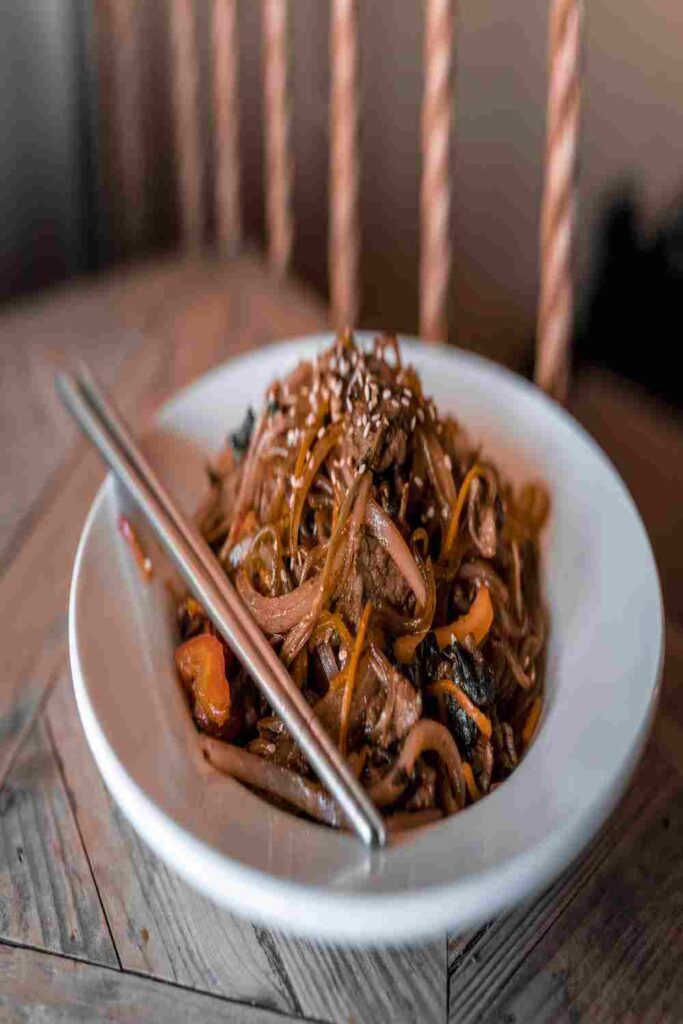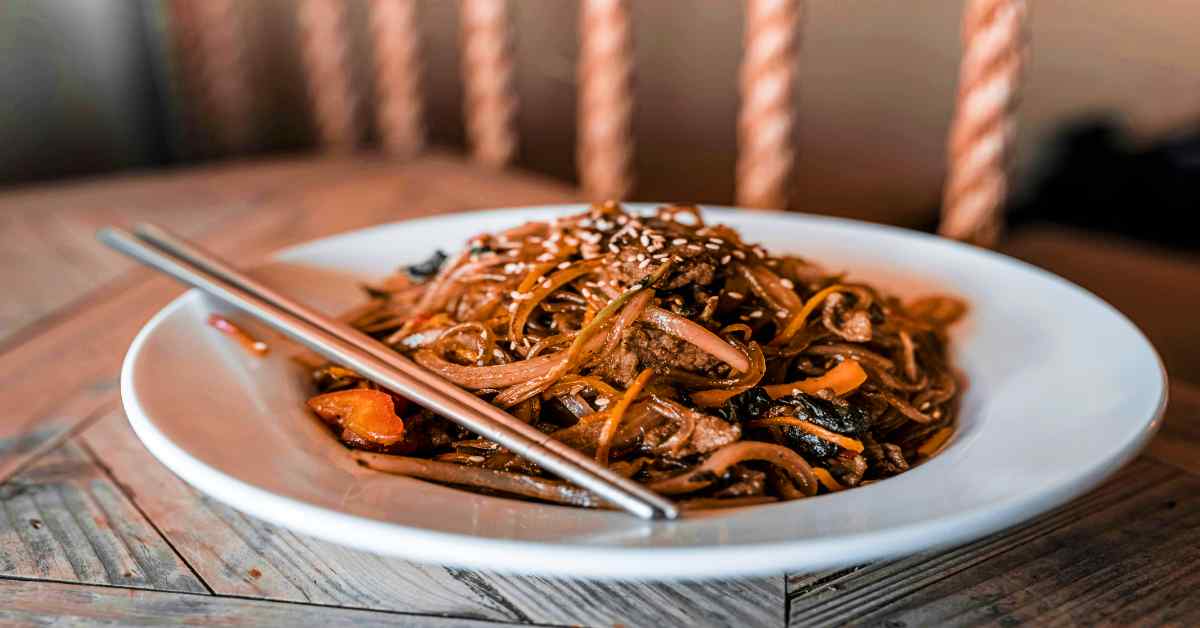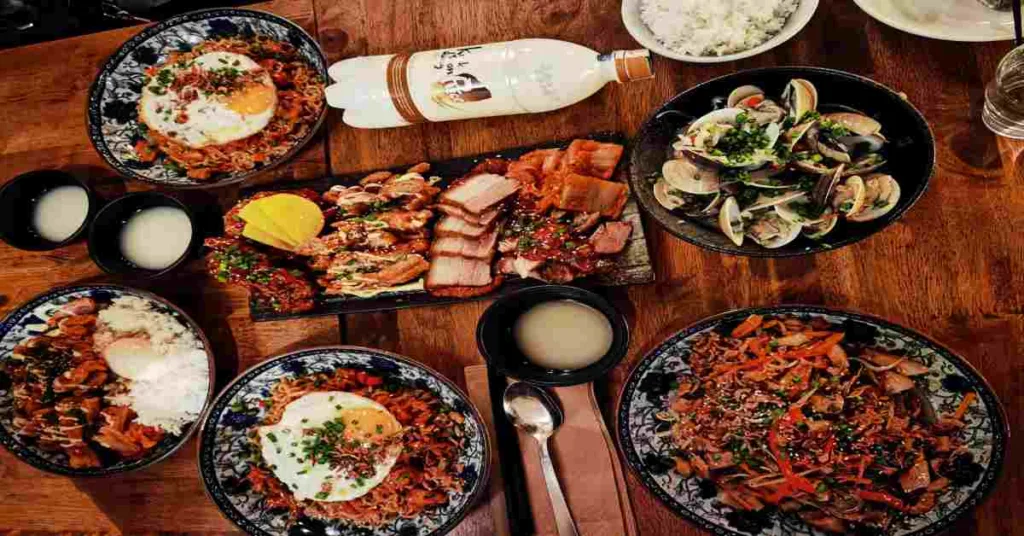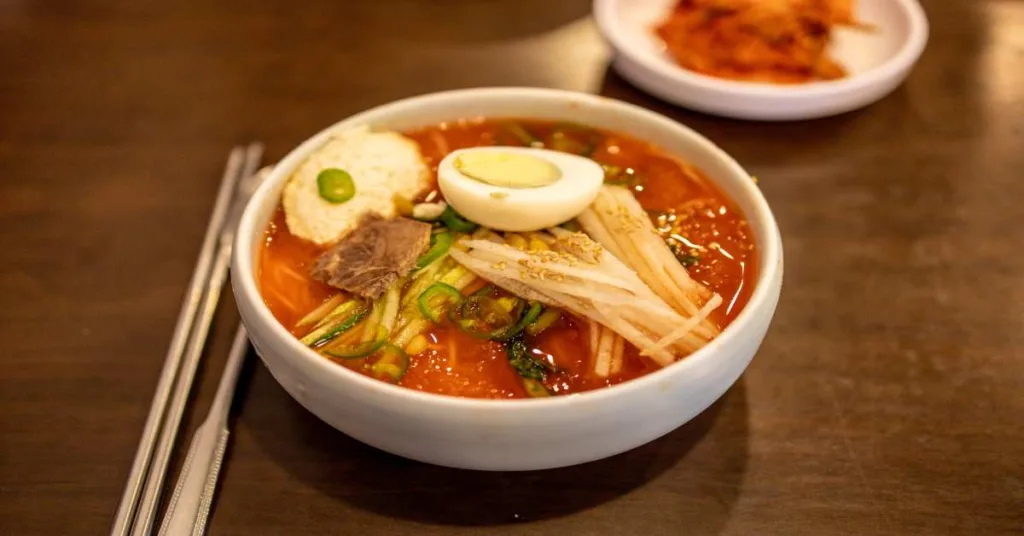Glass noodles are stir-fried with beef, mushrooms, and a variety of other veggies in sesame oil to make Japchae, which is arguably Korea’s favorite noodle meal. These translucent, fine noodles are made from sweet potatoes.
Unlike other Asian noodle dishes that are soupy, Koreans find it uncomfortable to eat with a bowl so close to the mouth. So they use metal chopsticks and a spoon to eat these delicious noodles.

What is Japchae?
Japchae is a typical Korean noodle dish made with stir-fried sweet potato, thinly shredded veggies, meat, and a hint of soy sauce and sugar. It is made with Dangmyeon, or “glass noodles,” which are a type of transparent Korean noodles.
It is frequently served as a side dish at lunch or dinner. Depending on the chef, extra ingredients are mixed in, such as mushrooms. Japchae is renowned for its rich, sweet taste as well as its soft, slightly chewy texture. Perfectly balanced sweet and salty japchae sauce is the key to the dish’s greatest flavor. You can add as much color and meat as you like to the dish, or you can consume vegan food.
During the Joseon Dynasty, a civil servant created a dish as a present for the king that is the ancestor of japchae. Japchae is claimed to have become the king’s favorite food after he discovered how delicious it was. It is also said to have aided officials in moving through the ranks. Many Korean homes adore this simple japchae dish.
Traditionally, the cooked noodles and other ingredients for Japchae are combined by hand rather than being stir-fried in a wok.
“ Korean word “mixed veggies” is “japchae.” When japchae was invented in the 17th century, it is believed to have been a dish without noodles. But these days, sleek glass noodles are one of the dish’s main ingredients.
Traditionally, each of the Japchae’s ingredients, including the meat and vegetables, is prepared and cooked separately before being combined with the noodles. This ensures that every vegetable is cooked to the ideal level of crunchiness while preserving its unique color, texture, and flavor. Japchae is such a special dish that it deserves to be pampered and prepared perfectly, even if it does take some time. With the ideal ratio of carbohydrates, protein, and vegetables, it is a complete meal in and of itself.
You can serve japchae hot, warm, or at room temperature. It is frequently offered as an appetizer, a side dish, or as a main dish when placed over a bed of rice.
Japchae is a delicacy that is served at every Korean feast, including weddings, birthday celebrations, and other life-celebrating occasions.
There may be some individuals out there who have never had japchae, but once they have, they can’t stop eating it!
You may like – Bibim Naengmyeon (Korean Spicy Cold Noodles)
What is Dangmyeon (Korean glass noodles)?
When cooking Korean Japchae, the dungeon cannot be skipped or substituted with other kinds of noodles. In Korea, sweet potato glass noodles are referred to as dungeon. They are produced using sweet potato starch. They are naturally free of gluten because they don’t contain any wheat. It’s also known as Korean glass noodles.
It is a typical Korean pantry staple that is used in many Korean cuisines, including Japchae salad and Korean Braised Chicken (Andong jjimdak).
Dangmyeon is packaged in a dehydrated form. There are a few distinct kinds, but they are all functional. The noodles are hard and appear greyish. Once cooked, they develop a translucent, delicate, slightly slick, and springy texture. After cooking, you might need to use kitchen scissors to cut them in half or several times because the majority of glass noodle manufacturers make their products very long.
Japchae Recipe
Ingredients:
Korean glass noodles, beef or pork, oil, carrot, onions, spinach, bell pepper, mushrooms, sesame seeds, sesame oil.
For Beef seasoning: sugar, soy sauce, rice wine
For Japchae sauce: sugar, soy sauce, rice wine, oil, garlic, water, and black pepper.
Step 1: Glass noodles should be soaked in boiling water for 15 minutes, drained, and then placed away. The noodles will soften and become easier to cook after pre-soaking.
Step 2: Slice the beef (or pork) against the grain into matchstick-sized pieces, season with soy sauce, sugar, and sweet rice wine, and put aside.
Step 3: Put all the ingredients for the japchae sauce in a mixing dish and set it aside.
Step 4: In a large skillet or wok, heat 1 tablespoon of oil over medium-high heat. Stir-fry the onion, carrot, pepper, and a dash of salt until tender. Shiitake mushroom slices and one more pinch of salt are added. Stir-fry the food until it is tender. If necessary, add more oil.
Step 5: Add the spinach at the very end and stir-fry it until it wilts. The vegetables are moved to a big platter to cool when the skillet has been taken from the heat.
Step 6: Stir-fry the beef (or pork) in the pan for a final minute or two over high heat with the remaining 1 tablespoon oil. The meat’s juice will start to leak out. With the fluid in the pan still in it, transfer the meat to the large plate with the reserved vegetables.
Step 7: Drain the glass noodles, then add them to the pan with the pork juices. The noodles should be covered with japchae sauce before being combined. Allow the noodles to cook for 3–4 minutes over medium heat, or until they are soft and the sauce liquid has mostly been absorbed.
Step 8: Put the heat on low. Re-add the meat and vegetables to the skillet and place the noodles on top. Toss everything together to incorporate the sesame oil and seeds. If you would like, add more sesame oil. As desired, add more seasoning and taste.
TIPS:
- By skipping the beef (or pork) and the meat seasoning stage in the recipe, you may make this japchae vegan or vegetarian.
You may like to know – Top 10 International Dishes
What to serve with Japchae?
Japchae is a fantastic meal on its own, but it’s even better when paired with these well-liked meals and sides:
- Beef and veggie bulgogi
- Traditional geotjeori or kimchi made with napa cabbage (fresh kimchi)
- Mandu (Korean dumplings)
- Kimchi jeon(Savory Kimchi Pancakes)
How to store & reheat leftover Japchae?
Japchae can be served warm or at room temperature. Refrigeration is the best place to store leftovers for up to a week. Eventually, the Dangmyeon noodles will turn opaque and tough.
For the best results, reheat in a skillet over high heat or in the microwave until heated. A skillet with some oil in it should be heated to medium. Stir-fry the cold japchae with the addition of the warmed veggies until the noodles are transparent and tender. You’ll receive a plate of japchae that tastes just as though it was just prepared.


